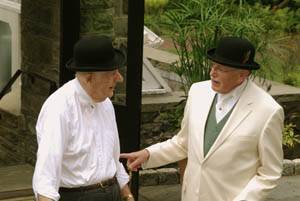Related Topics
Quakers: The Society of Friends
According to an old Quaker joke, the Holy Trinity consists of the fatherhood of God, the brotherhood of man, and the neighborhood of Philadelphia.
Science
Science
Nature Preservation
Nature preservation and nature destruction are different parts of an eternal process.
Touring Philadelphia's Western Regions
Philadelpia County had two hundred farms in 1950, but is now thickly settled in all directions. Western regions along the Schuylkill are still spread out somewhat; with many historic estates.
The Main Line
Like all cities, Philadelphia is filling in and choking up with subdivisions and development, in all directions from the center. The last place to fill up is the Welsh Barony, a tip of which can be said to extend all the way in town to the Art Museum.
Gardens Flowers and Horticulture
Gardening, flowers and the Flower Show are central to the social fabric of Philadelphia.
Quaker Gardens
New topic 2016-12-04 04:23:55 description
Fernery

|
| Gardeners |
As explained by the curator of The Morris Arboretum, there are a few other ferneries in the world, but the Morris has the only Victorian fernery still in existence in North America. That doesn't count a few shops that sell ferns and call themselves ferneries; we're talking about the rich man's expensive hobby of collecting rare examples of the fern family in an elaborate structure. That's called a Victorian fernery. The one we have in our neighborhood is really pretty interesting; worth a trip to Chestnut Hill to see it.
Although our fernery was first built by the siblings John and Lydia Morris, it was rebuilt at truly substantial cost by the philanthropist Dorrance Hamilton. It is partly above ground as a sort of greenhouse, and partly below ground, with goldfish and bridges over its pond. Maintaining an even temperature is accomplished by a complicated arrangement of heating pipes. The temperature the gardener chooses affects both the heating bill and the species of fern that will thrive there. You could go for 90 degrees, but practical considerations led to the choice of 58 degrees. The prevailing humidity will affect whether the fern reproduction is sexual or asexual, a source of great excitement in 1840, but survivors of Haight-Asbury are often more complacent on the humidity point.
There are little ferns, big ferns, tree ferns, green ferns, and not-so-green ferns; the known extent of ferns runs to around five hundred species. Not all of them can be found in Chestnut Hill, what with humidity and all, but there are enough to make a very attractive and interesting display. For botanists, this is a must-see exhibit. For the rest of us, it's probably the only one of its kind we will ever see, a jewel in Philadelphia's crown, and shame on you if you pass it by.
Originally published: Wednesday, July 18, 2007; most-recently modified: Friday, May 17, 2019